Eyes on the Sky for Mercury
On 9 May, Mercury will be seen as a black dot silhouetted against the Sun and this rare event enabled astronomers of the 17th century to work out how vast the universe was. But this transit isn't just phenomenally important historically: it has huge implications in our search for extraterrestrial life, as Graihagh Jackson finds out...
In this episode
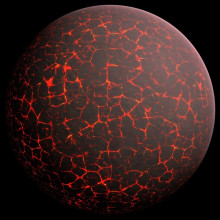
01:00 - Want to see Mercury in 2016?
Want to see Mercury in 2016?
with Professor David Rothery, Open University
On 9 May, Mercury will be seen as a black dot silhouetted against the Sun... but 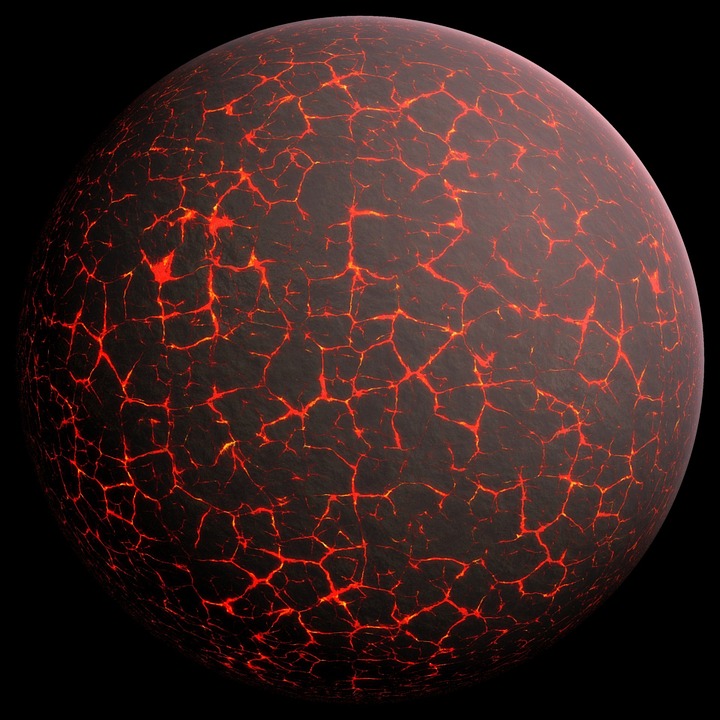 why are scientists so excited about it? David Rothery spoke to Graihagh Jackson about its importance and how to watch the event safely...
why are scientists so excited about it? David Rothery spoke to Graihagh Jackson about its importance and how to watch the event safely...
David - A transit is when one of the two planets closer to the Sun than the Earth passes directly between the Sun and the Earth, and then we see the planet silhouetted as a tiny black dot against the Sun's disc.
Graihagh - Why is that exciting?
David - Well, particularly for Mercury, I'm working on a space mission to Mercury - it's my planet! And it's very hard to see in the evening or morning sky because it's always so close to the sun and when it's in front of the sun (transiting it) you can't miss it if you've got the right equipment to look at it. It's a little bit of a thrill to see this; it doesn't happen very often.
Graihagh - How often does it happen?
David - Well... the last one was in November, 2006 but it started just before sunset in the UK so we didn't get much of a chance to see it. Before that it was May, 2003 and it was very early in the morning. But this one on May 9th is perfect timing for us because it starts just after midday (12.12. BST) and it finishes at 19.42 BST so, if there are no clouds, we'll see the whole of it.
Graihagh - So it means you don't have to get up too early and, alas, dress up nice and warm?
David - It's May in Britain - it'll be sunny, there'll be a few fluffy clouds, blue sky and a nice sun. But, we've got to say this - you should not look at the Sun without proper gear to see this. It's too tiny to see with the unaided eye anyway. It's 150th the solar diameter when it's sitting in front of the sun. You need a magnified image and what you mustn't do is try binoculars or a telescope or anything like that. You have to project an image onto a card or use a proper solar filter in front of a telescope to cut the light out or go to an event. There are lots of events that you can find or just stay at home and look at it on the internet.
Graihagh - I mean, I think I'd rather see it in the flesh, even if it is indirectly! You can find out whether there are events near you - www.nakedscientists.com/mercury transit. But if you're not lucky enough to have some Mercury display happening on your doorstep, all is not lost...
David - OK, well this is what I used to do when I was a lad. You focus your telescope on some distant trees just to get it into focus. Then you swing it round until it's pointed at the Sun but you do not look through the eyepiece. You hold a white care a couple of feet behind the eyepiece of the telescope and you will see a projected image of the Sun. But don't look through it because you'll burn your eyes out - it's very, very, dangerous.
Graihagh - OK, I'll be well behaved. Don't you worry David. And I presume of the projected card you see the sun but then you also see Mercury transiting across the Sun, maybe like a dark patch or something?
David - Mercury will be a tiny black dot. I mean, if the sun's image is 6 cm across, Mercury will be half a millimeter, so it's tiny.
Graihagh - Wow. OK, so it might be quite tricky to see in that case...
David - Look carefully, but it will be there.
Graihagh - OK. Now you said you study Mercury and you're particularly excited about this transit because it means you'll be able to see it at a more sociable hour, but how much can you really ell?
David - The transit isn't actually useful to us scientifically these days. There's nothing we can learn from Mercury but watching it transit but it it's nice to see the planet doing it.
Graihagh - I agree but just because it isn't so scientifically important these days, doesn't mean it wasn't once. Venus was the first transit observed in 1639, just outside of Manchester, by a chap Jeremiah Horrocks.
What I like about Jeremiah's story is that in those days, there wasn't a specialised astronomical telescope market - funny that - and so stargazers had to build their own. Jeremiah's father and uncles were watchmakers and as a result, well practised in the art of precision instruments. By day he worked for them and in return, they helped him build the best telescope they could. And it was with a watchmakers telescope, he indirectly observed Venus transit across the sun - using the method David described before.
Now, let's get to why this is important.
Skip forward 50 or so years and Edmond Halley publishes a paper, describing how if you can observe a transit from multiple places from Earth, using triangulation, you can work out how far the Sun from the Earth is - now known as the astronomical unit.
David - It's important because, if you cast yourself back to the 17th century, we did not know how big the solar system was. It was late in the 16th, early in the 17th century when opinion was swinging away from the old view of the solar system, which had everything going round the earth, to accepting what Copernicus had said - look, the Sun's in the middle and everything else goes round the Sun. And once that was realised, it became important to work out well how big is all this? I mean you want know how far away things are.
Graihagh - Halley died 19 years before the Mercury Transit in 1942 BUT naturalists from France, Austria and Britain were packed off on various expeditions far and wide across the world to observe the rare phenomenon.... As far as Siberia, Norway, Newfoundland and Madagascar. All this wasn't underpinned by our quest to understand the size of our universe though it was good old fashioned competition! Indeed, that's why Captain James Cooke was packed off to Tahiti on his first tour of the world!
Their findings? Well, what was reported in the Philosophical Transitions journal was:
"the mean distance from the Earth to the Sun (is) 93,726,900 English miles."
We now know today that's it's 92,955,000 miles. That means they were off just by 0.008% - pretty remarkable really, considering this was the mid 1700s!
David - So this is was a step towards realising the scale of the universe - which is vast!
Graihagh - Back then, it was transiting planets in our solar system, but now scientists watch exoplanets transit - that's planets orbiting around OTHER stars. And turns out you can tell quite a lot more than just how far away they are...
David - There are many exoplanets we are observing in very close orbits around their stars. So the travel faster and a transit may last a matter of minutes or an hour or so but it's never as quick as just being over in seconds.
Graihagh - OK, but what I was keen to know was: what can you find out about a transiting exoplanet in that short window of time?
David - Measuring transits is a way of timing the orbits of planets around other stars and measuring their size. So you can have a go at working out their densities and what their properties might be. But to actually measure something, the thing you can really measure is the planet's atmosphere. If it has a dense atmosphere, the starlight shining through the atmosphere will be affected by that atmosphere, so you'll just get faint lines superimposed on the spectrum of the star corresponding to the gases in that planet's atmosphere. It's a very, very careful, subtle observation just looking at how the quality of the starlight changes when the planet's in front of it. If the starlight dims because the planet's blotting out a tiny portion of the star's disc and the light that gets to you, a tiny fraction of that is shining through the planet's atmosphere. So it's spectroscopy looking at spectral lines.
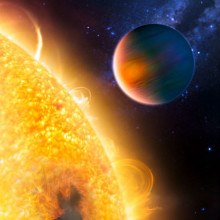
09:37 - Exoplanet exploration
Exoplanet exploration
with Dr Carole Haswell, The Open University
Carole Haswell talks Graihagh Jackson through how and why she studies planets 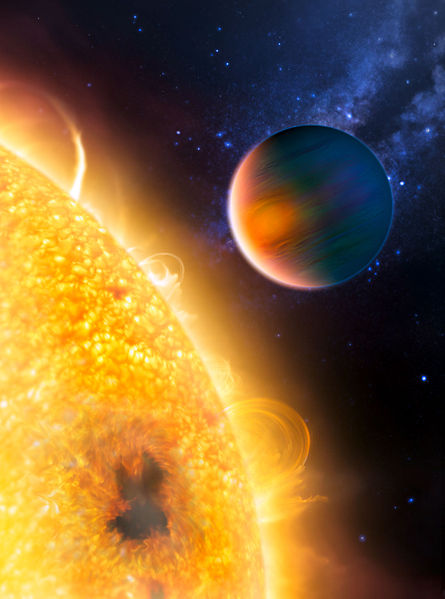 beyond our own solar system...
beyond our own solar system...
Carole - My name is Carole Haswell. I'm an astrophysicist at the Open University where I do research on exoplanets.
Graihagh - And Carole uses this transiting method that David was talking about to study exoplanets. But what really amazed me about Carole was that when she heard of a particular transiting exoplanet, it literally changed the course of her life...
Carole - As a very young child I knew that I wanted to be an astronomer and, like many young people, I thought that I wanted to do cosmology just because seemed like the ultimate thing to do. And then, I think, as I got older and actually started studying at university, then I realised that actually, cosmology seemed to me to be a little bit abstract and removed from things that I could identify with and so, at that point, I decided that I wanted to work instead on things closer to home.
So, I in fact started my research career still doing something that's quite far out. I was working on accretion around black hole binary star systems and I did enjoy that but in, I think it was about 2003, I saw a paper which had observed an exoplanet using the Hubble space telescope. And when a planet passes in front of a star from our point of view, it blocks say 1% of the light from the star and produces a very subtle dip every time it goes round the orbit. But this particular paper, they had used the Hubble space telescope to look in the ultraviolet and they had seen, instead of a 1% very subtle dip, a 15% diminishing in the light from the star and this told us that the planet was actually surrounded by a huge cloud of hydrogen. And, at that point, I thought this is just too exciting and exoplanets are the way to go.
Graihagh - I mean obviously it had a profound importance for you but what was the importance of that discovery more generally in the scientific community I'm thinking?
Carole - What that paved the way for was the whole field of being able to actually assess the chemical composition of exoplanets. So, here you have a planet orbiting a distant star and because the planet is surrounded by some gas, which is translucent. The gas is made up of atoms and ions which absorb light at particular wavelengths.
Graihagh - I think of it like a looking at a rainbow. Whilst hydrogen may block one frequency of light - red let's say - methane might block green. So you have a rainbow - or spectrum of light - that goes mm and YELLOW and PINK and mm! PURPLE and ORANGE and BLUE!
And by looking at what's colours are missing you can work out what elements are found in the atmosphere of this extremely, distant planet. Soooooo coool.
Carole - So it really opened the field for being able to actually measure what planets outside our own solar system are made of or at least what their atmospheres and the surround gas cloud is made of.
Graihagh - What I find absolutely insane is that these exoplanets are a long, long, way away. I mean, how far are we talking in light years?
Carole - Well the very, very closest star is about 4 light years away and, obviously, most stars are very much further away than that - hundreds or more light years away. So the transit method has found thousands planets or planet candidates. Not all of them have been completely verified but it's been extremely successful at finding planets
Graihagh - And like David's DIY to watching the Mercury transit, Carole also has a similar attitude...
Carole - There have been missions, projects like SuperWASP, which is a UK project which I, and many of my colleagues, were involved in which actually used very, very cheap equipment. Some of it I actually bought on eBay...
Graihagh - No really!
Carole - Yes. So because it's a fairly simple measurement just to measure the brightness of the star, we were able to use camera lenses that had actually been designed for doing things like theatre photography. We put them on a telescope mount and pointed them to the sky and used those to measure the brightness of thousand of stars over and over again. And the SuperWASP project has now discovered I think about 150 or 160 planets using that very modest equipment
Graihagh - Something else to try at home guys, seriously... Perhaps you could even name an exoplanet after yourself?? Anyway, back to the rainbow stuff, what actual elements have been discovered so far?
Carole - Ok so there's been quite a number elements detected and the other early discoveries that I should mention was the detection of sodium in the atmosphere of the very first known transiting exoplanet, and there have been many, many more discoveries including things as heavy as iron.
Graihagh - And I'm sure Carole would agree, there are probably many more elements to discovered when it comes to exoplanets!
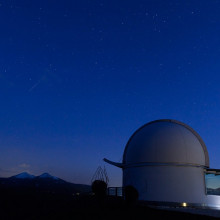
15:15 - Searching for signs of life
Searching for signs of life
with Patrick Short, Sanger Institute
Studying exoplanets and their transits has yeilded lots of interesting information 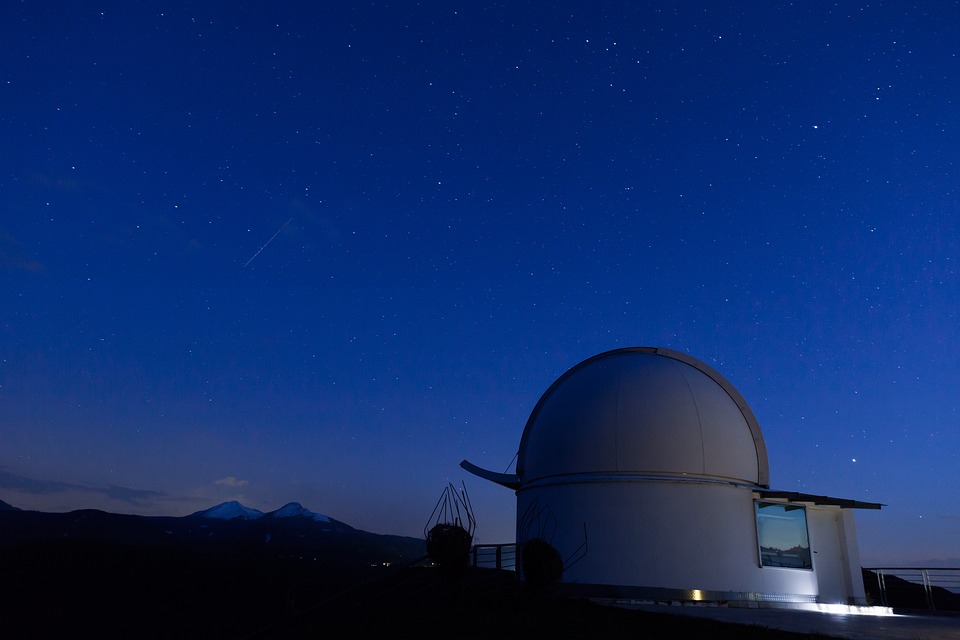 on what their atmosphere is made of. But they're so far away, so what's the point? Why do we care what's circulating in their atmospheres? Graihagh Jackson put this to Patrick Short...
on what their atmosphere is made of. But they're so far away, so what's the point? Why do we care what's circulating in their atmospheres? Graihagh Jackson put this to Patrick Short...
Patrick - It's important because these gases, and elements, and these sorts of things give us an idea of whether a planet might support life to begin with
Graihagh - That's Patrick Short who is a PhD student based at the Sanger Institute. I met him because he competed in a science communication competition called FameLab where applicants have to get up on stage and give a talk about something they feel passionate about. Patrick's topic? The quest to find ET.
Patrick - And then also it could provide clues of whether life actually exists. So methane, for instance, is produced by most living things here on earth so if we see a planet with a huge methane signature then it's probably a pretty good place to search.
Graihagh - What are the chances there is actually life out there? I know thousands of exoplanets have been discovered but really, is it likely that there's life out there in the first place?
Patrick - Yes, it's an important question. Actually, one that has vexed a lot of people for a long time so there have been some attempts to quantify this. One of the big distractions or criticisms is, I guess, that there are just so many unknowns that it's really hard to put a firm yes or no or even a probability of life in our galaxy or in other galaxies somewhere else in the universe but there have been quite a few pretty valiant stabs at it. So the most famous one was by Dr Frank Drake and he actually didn't intend it to really be his legacy or to be the thing that he was remembered for. It was basically intended to drum up conversation at a conference and the idea was basically to put a rough, back of the envelope calculation on what is the probability that we find life somewhere in our galaxy.
Graihagh - At this stage I think it would be a really good idea to go through Drake's equation to understand a bit more about what these limitation are. So what is the first item in the equation?
Patrick - So the first item is the rate of star formation in the galaxy. So they express this in terms of number of stars per year. So the Milky Way is about 13 billion years old and Drake puts his first estimate at 1 star per year. So that's a first step.
Graihagh - So 13 billion - let's write that down.
Patrick - So this would be n and star I guess...
Graihagh - OK. What next?
Patrick - So next is what proportion of these stars have planets around them. So not all stars have planets and Drake put this at somewhere between ⅕ and ½ . And then we've also got the number of planets per star. So given that it's got a planet, how many does it have in general and he puts this at between one and five. Given that you've got a star that's got planets we'll assume conservatively that it's got one planet and we'll assume aggressively that it's got five habitable planets per star.
Graihagh - And when we're talking habitable we mean the right sort of temperature, that it's got an atmosphere, and it doesn't spin too fast, it doesn't spin too slowly. All these types of things that are needed for life.
Patrick - Yes, exactly.
Graihagh - So we've got number and stars and then how many habitable planets around those stars. So what's next after that?
Patrick - Then we've got the probability that a habitable planet will result in life. So, I guess, you can consider it the probability that given all the right conditions to find that habitable planet that life will arise on that planet and Drake puts that at one. So he's quite an optimist - he says if we've got a star with a habitable planet then life will arise on that planet. And then this follows quite closely by the second term which is the probability that that life will turn into intelligent life, which Drake also puts at one. So he thinks that it's inevitable that if life is created it follows to intelligent life.
Graihagh - After this, there's still more is there?
Patrick - Yes. So then there's the probability that they don't develop communication skills so Drake was specifically interested in looking for civilisations that would have made contact with us or that we could make contact with. And he puts their probability of developing communication at between 1/10 and ⅕, so 0.1 and 0.2.
Graihagh - OK - communication. Surely that's the final one?
Patrick - No - we've actually got one more. So Drake has factored in exactly how long these communications will last. We we've been doing our search for extraterrestrial intelligence listening not broadcasting but only for a few decades so he places his lower bound and upper bound between somewhere between 1,000 and 100 million years.
Graihagh - OK. So if we take this equation and we do the conservative estimate, what do we get?
Patrick - So the conservative estimate which is: 13 billion stars, ⅕ of which planets, one of which is habitable and which we develop life 100% of the time, intelligent life another 100% of the time, 10% of the time they develop communication tools and they only use these communication tools for 1,000 years. Then Drake estimates that we would have actually only have about 20 habitable planets in our galaxy, which is the Milky Way.
Graihagh - That doesn't seem like very many. What about on the other end of the spectrum?
Patrick - On the other end of the spectrum if you want to go with Drake's most optimistic estimates, then Drake arrives at a maximum of 50 million intelligent species within our galaxy and again, that's just within the Milky Way. So we've got another hundred billion of these galaxies out there so, even if we pick Drake's lowest estimate which is 20, then we've got in the order of 2 trillion intelligent species that we could get in contact with.
Graihagh - I mean that sounds incredibly high so why the heck have we not been able to make contact with any of these civilisations or, indeed, they make contact with us?
Patrick - Yes, so that opens up a whole other famous chapter of physics history. So this question was asked by Enrico Fermi, he's a physicist and, I think the exact terminology he used is "if this is the case then where is everybody." And his point being that if we accept that somewhere between this conservative and aggressive estimate of the amount of life out there that surely either we should have heard somebody, detected something or had somebody get in contact with us. And especially the extra layer of evidence is that we're actually somewhat young in terms of the history of the universe. So, if we can imagine our society fast forwarding just a few hundred million years, then we should most certainly be able to colonise the galaxy and do all these intergalactic travels and certainly communication but, the fact of the matter is, we haven't heard from anybody. So the paradox here is if we can accept that the universe is teeming with life and one of the possible explanations for why we haven't heard from anybody and there's quite a few interesting ones, I think.
Graihagh - Like what?
Patrick - One of my favourites is this idea that if we consider ourselves young in terms of the intelligent life spectrum, then any other intelligent life out there that was older than us may be so incredibly advanced and more developed than us that they don't actually consider us to be intelligent life. Think of our relationship with ants; they communicate with scent and we really don't spend a lot of time trying to device scent systems to try and communicate with the ants. And then there's other more practical considerations that it may be that some of these estimates are of,f and there is life out there but it's so far spread out that the physical limitations of the universe make it impossible for us to communicate with one another in practical amount of time. And maybe they've tried to communicate with us but it's still on it's way so it's just being sent across the universe at light speed and maybe some day we'll hear it.
Graihagh - We could speculate all day on the possibilities but Fermi's problem still stands. Where is everybody? And then that sorta makes me ask, well why are we bothering anyway... Sat in the sun with Patrick in a park, with kids mucking about on the swings, I realised that one of the things we enjoy the most (and I suppose makes us fundamentally human) is that interaction with others. And that combine with our curiosity, well, then the search for life elsewhere in the universe, despite all it improbabilities, is still worth it.
Patrick - Yes, I'm very optimistic. I would be thrilled if we found life somewhere else. I think it would be super exciting. I don't know, I guess we'll just have to wait and see but... who knows?
- Previous The Secret World of Shipping
- Next How fast can an elevator go?










Comments
Add a comment